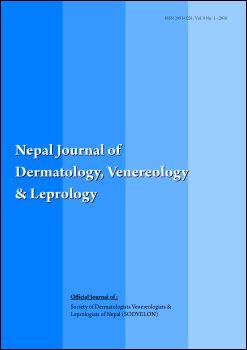Profile of Vitiligo in Western Nepal
DOI:
https://doi.org/10.3126/njdvl.v9i1.5771Keywords:
Clinical Profile, Vitiligo, Western Nepal.Abstract
Background Vitiligo is common worldwide. The highest incidence is reported from Indian subcontinent. However, there are only few studies available on epidemiology of vitiligo from Nepal
Objective To determine the clinical patterns of vitiligo, the associated sociodemographic factors and its associated disorders among patients attending dermatology outpatient department of Manipal Teaching Hospital, Gandaki Medical College Teaching Hospital and Fishtail Hospital and Research Center Pokhara.
Methods All patients presenting with signs and symptoms suggestive of vitiligo over a period of one-year (from march 2009 to march 2010 ) at the out-patient clinics in the Dermatology Department of Manipal Teaching Hospital, Gandaki Medical College Teaching Hospital and Fishtail Hospital and Research Center, Pokhara were included in the study. Socio-demographic details regarding age, sex, marital status, education and occupation were recorded .A detailed clinical history related to the presenting complain and clinical examination findings were recorded. Relevant available investigations were ordered based on signs and symptoms to determine if any associated disorders.
Results Two hundred and twenty four patients with clinical diagnosis of vitiligo were studied. Males constituted 102 (45%) patients and females 122 (55%) of the total number of patients. Duration of disease at the time of presentation ranged from two weeks to 40 years. The lower limb was the initial site of onset of vitiligo in majority 77 (34.37%) of the patients, followed by the upper limbs, head and neck, trunk and mucosae in decreasing order of frequency. The commonest clinical pattern found was vitiligo vulgaris followed by acrofacial, segmental and mucosal types. Lesions showing leukotrichia were observed in 40 (18.87%) patients and koebnerization was observed in 42 (18.75%) patients. Eleven children had halo nevi. Associated abnormalities included alopecia areata (13 patients), diabetes mellitus (12 patients) and one patient had atopic dermatitis. A positive family history was obtained in 14(6.25%) of the patients.
Conclusion Vitiligo vulgaris is on of the common clinical-type skin disorder observed in Nepal. There w e re associated disorders/abnormalities in some patients such as alopecia areata , diabetes mellitus and atopic dermatitis.
Keywords Clinical Profile; Vitiligo; Western Nepal.
DOI: http://dx.doi.org/10.3126/njdvl.v9i1.5771
NJDVL 2010; 9(1): 40-43
Downloads
Downloads
How to Cite
Issue
Section
License
Copyright on any research article is transferred in full to Nepal Journal of Dermatology, Venereology & Leprology upon publication. The copyright transfer includes the right to reproduce and distribute the article in any form of reproduction (printing, electronic media or any other form).




